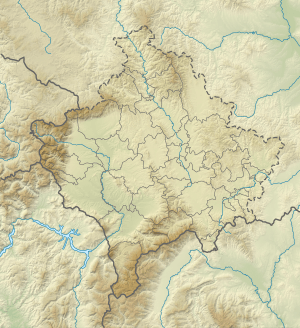Đeravica
Đeravica or Gjeravica (Albanian: Gjeravica; Serbian Cyrillic: Ђеравица) is the second-highest mountain peak in the Prokletije mountain range and the Dinaric Alps chain, after Maja Jezercë. It is the second-highest[6][7] mountain in Kosovo,[lower-alpha 1] or the second-highest mountain of Serbia, according to the Serbian government position over its status. It has an elevation of 2,656 m (8,714 ft) above sea level.[1][2][3][4] Đeravica is in the western part of Kosovo, in the municipality of Junik. Before the 20th century, Đeravica used to be called Kaluđerovica (Kaluđer means monk in Serbian).
| Đeravica | |
|---|---|
| Gjeravica | |
 Đeravica | |
| Highest point | |
| Elevation | 2,656 m (8,714 ft) [1][2][3][4] |
| Prominence | 1,018 m (3,340 ft) [5] |
| Coordinates | 42°32′1″N 20°08′24″E |
| Naming | |
| Pronunciation | Albanian pronunciation: [ɟɛɾavitsa] Serbian: [dʑɛraʋitsa] |
| Geography | |
 Đeravica Location of Đeravica in Kosovo | |
| Location | near Deçan, Kosovo[lower-alpha 1] |
| Parent range | Prokletije |
Features
Đeravica is somewhat different from the rest of the Prokletije mountains in its lack of the stony, limestone texture the other mountains in Prokletije have. Many large and small glacial lakes can be found near the summit. The largest of the lakes is Đeravica Lake, which is just under the summit and is the origin of the Erenik river.
Đeravica and the Prokletije are mostly known for the growth of chestnuts. There are also wild strawberries growing in Đeravica during the summer.
Geography
Nearby peaks
- Kumulore
- Tropojske Pločice
- Guri i Gjate
- Maja e Ram Arućit
- Ljogi i Prelš
Cliffs
- Biga Tamas
- Krši i Ćenit
- Kumulore
- Krši i Zi
- Guri i Mal
- Gurt e Ljove
- Brehov
- Minarja
Nearby springs
- Kroni Tedel
- Kroni Gusija
- Kroni i Lizit
- Kroni i Nuses
- Gura e Hasanags
- Kroni i Metes
- Gura e Mir
- Kroni i Rasave
- Kroni i Smajlit
- Gura i Ćuršis
- Gura Hođs
- Kroni i Mir
Notes
- Kosovo is the subject of a territorial dispute between the Republic of Kosovo and the Republic of Serbia. The Republic of Kosovo unilaterally declared independence on 17 February 2008, but Serbia continues to claim it as part of its own sovereign territory. The two governments began to normalise relations in 2013, as part of the 2013 Brussels Agreement. Kosovo is currently recognized as an independent state by 97 out of the 193 United Nations member states. In total, 112 UN member states recognized Kosovo at some point, of which 15 later withdrew their recognition.
References
- "CIA World Factbook 2014: Kosovo" (PDF). Central Intelligence Agency. 2014. Retrieved 5 April 2015.
- "CIA World Factbook 1999". Central Intelligence Agency. 1999. Retrieved 5 April 2015.
- "Facts about Serbia: Position, relief and climate". Government of Serbia. Archived from the original on 9 October 2014. Retrieved 5 April 2015.
- "Facts about Serbia". National Tourism Organisation of Serbia. 2015. Retrieved 5 April 2015.
- "Daravica, Kosovo". Peakbagger.com. Retrieved 5 April 2015.
- http://www.countryhighpoints.com/serbia-midzor/
- https://www.youtube.com/watch?v=RTdeVLDxMMY&t=3s
External links
| Wikimedia Commons has media related to Đeravica. |
- Summitpost, Đeravica
- "Đeravica". Peakware.com. Archived from the original on 4 March 2016.
- Peakbagger, Đeravica